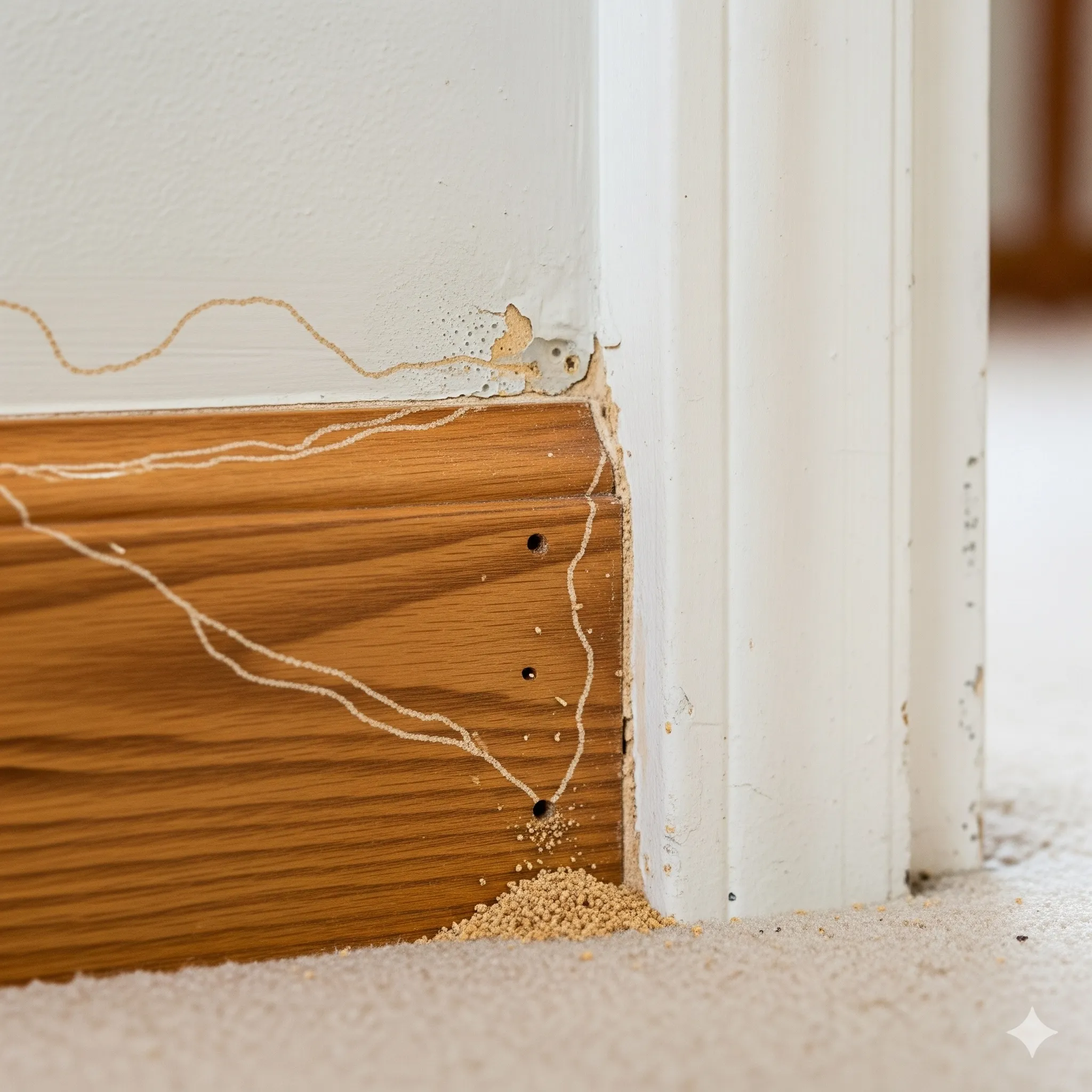Termites can cause devastating damage to your property if left unchecked. Their destructive nature is why they're often called "silent destroyers." By the time you see visible damage, the infestation may already be well-established. Fortunately, they often leave behind subtle clues. Recognising these early warning signs can save you from significant structural repairs and heartache. Here are 9 critical signs to watch out for in your Sydney or Brisbane home.

1. Termite Droppings (Frass)
Subterranean termites and drywood termites leave behind distinct piles of fecal pellets, known as frass. These pellets are small, dry, and often look like tiny dark specks or sawdust. They are usually found near small holes or in piles beneath damaged wood.
- What to look for: Small piles of sawdust-like material, often near skirting boards or wooden furniture.
- Significance: This is a strong indicator of active drywood termites within your structure.
2. Mud Tubes
Subterranean termites, common in both Sydney and Brisbane's humid climates, build mud tubes or tunnels. These are pathways constructed from soil, mud, and saliva, providing shelter and maintaining moisture for the colony as they travel between their underground nests and food sources.
- What to look for: Pencil-thick or wider mud-like tubes running along foundation walls, support beams, floor joists, or even up into wall cavities.
- Significance: Presence of mud tubes is a definitive sign of subterranean termites, indicating they are actively foraging on your property.
3. Wood Damage That's Hollow
When termites consume wood, they typically eat it from the inside out, leaving the outer layer intact. This can make the wood sound hollow when tapped.
- What to look for: Tap on wooden structures like floorboards, walls, or furniture. If it sounds hollow or papery, it could be infested. You might also notice the wood is soft or crumbly.
- Significance: This indicates termites have been actively tunnelling and feeding within the wood.
4. Peeling or Bubbling Paint
Termites often leave a thin layer of wood or plaster between their tunnels and the surface of your walls. This can cause paint to bubble or peel, especially if there's moisture involved.
- What to look for: Areas of paint that look uneven, blistered, or are flaking off, particularly on wooden surfaces or where wood meets plaster.
- Significance: This can mimic water damage but is often a sign of termite activity underneath.
5. Maze-Like Patterns in Wood
If you notice that wooden surfaces show intricate, maze-like patterns or tunnels underneath the surface, it's a strong indicator of termite activity.
- What to look for: Inspect exposed wood for these internal tunnel systems, often visible if the wood is damaged or broken.
- Significance: These are the galleries termites create as they tunnel through and consume wood.
6. Swarmers or Discarded Wings
During certain times of the year, especially after rain, termite reproductives (swarmers) may emerge from the colony to mate and start new colonies. You might see them flying or discover piles of their shed wings.
- What to look for: Small, winged insects resembling flying ants, or collections of translucent wings, often found on windowsills or near light sources.
- Significance: Seeing swarmers or their wings is a strong sign that a termite colony is nearby, and potentially established in or on your property.
7. Creaking Floors or Ceilings
As termites weaken floorboards, joists, or ceiling beams, the structural integrity of these elements can be compromised. This can lead to unusual creaking noises when you walk across floors or when the house settles.
- What to look for: New or unusual sounds of wood groaning or creaking, especially in areas with potential termite damage.
- Significance: This suggests that the wood has been structurally weakened by termite activity.
8. Strange Odours
Some termite species can produce distinct odours. For instance, dampwood termites might emit a musty, mildew-like smell due to the fungi they promote in damp wood. While not as common as other signs, it's worth noting.
- What to look for: A persistent, unpleasant smell in certain areas of your home, particularly near wooden structures.
- Significance: This could indicate a hidden infestation or a high level of moisture that attracts termites.
9. Difficulty Opening Doors or Windows
When termites tunnel through door frames or window frames, they can weaken the wood, causing it to warp and sag. This structural shift can make it difficult to open and close these fixtures smoothly.
- What to look for: Doors or windows that stick, jam, or are difficult to operate, with no apparent cause like humidity.
- Significance: This could be a sign that the surrounding wooden frames are compromised and weakened by termite activity.
Don't Wait – Act Fast!
Spotting any of these signs is a clear indication that you should seek professional help immediately. Termite damage can escalate quickly, leading to extensive and expensive repairs. Xpress Pest Control Pest Control offers comprehensive termite inspections and treatments tailored for the unique conditions in Sydney and Brisbane. Our experienced technicians can identify the type of termite, pinpoint the infestation, and implement effective solutions to protect your home.
